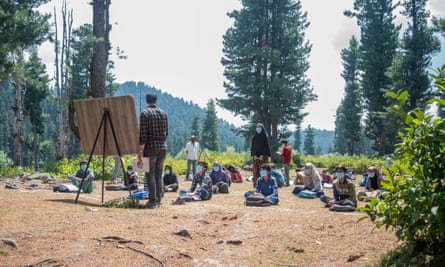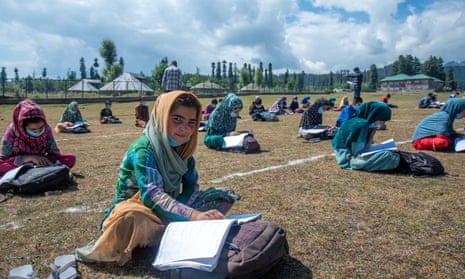Asmat Jan, 15, practises her singing in a meadow, against a backdrop of Kashmir’s towering mountains. In front of her, around 50 other children squat in perfect, straight lines. A couple of adults hover nearby.
Education has gone open-air across the valley in Indian-administered Kashmir and this is one of the many makeshift community classes that have sprung up in response to the repeated closure of schools under two separate lockdowns, alongside a communication blackout in this hotly disputed territory imposed in August last year. While political restrictions have eased a little in Kashmir since India revoked the region’s special status and degree of autonomy, a brief reopening of education in February lasted only until April’s Covid-19 lockdown brought classes to yet another grinding halt.
“We used to cry when the schools shut down. We thought we will never be able to progress in life. We had even forgotten that we are students,” Asmat says.
Asmat belongs to a nomadic family. Nobody in her family has had a formal education. For an entire year, Asmat studied on her own and would receive help from her brother, who attended school to secondary level and now works as a manual labourer.
Many children in India have been given access to education via digital technology during the Covid-19 pandemic, but Asmat does not own a smartphone.
“These students are from poor families, who find it difficult to make ends meet. Owning smartphones that cost around 10,000 to 15,000 rupees (£100-£150), is a far cry [from] them,” says Mushtaq Ahmed Mir.
Mir works with the local education department. His job is to survey around 7,500 children studying in his area, and to co-ordinate their educational requirements. When out and about, Mir often slows down to ask children why they are not at their lessons.
“Before Covid-19, there was a lockdown and people were unable to leave their homes. Even then, we tried to reach out to the students. Our family members used to be scared for our lives and safety, but we would risk our lives,” Mir says.
“Our concern is that if we don’t act right now, students from our schools might drop out.” Mir says that they have to act with a sense of urgency. Past surveys have shown an increase in school drop-out rates after disruption to education, and there are months of curfew almost every other year in the valley.

Community classes are now being held in fields, orchards and pine forests. Face masks and sanitiser are provided by the teachers. Efforts are made to ensure that children follow social distancing.
But such safety concerns are accompanied by many other dangers, according to Mohammad Ramzan Wani, an education official. “In the jungle area, we have to be wary of the wild animals. The road to this place is also treacherous. Children have to cross rivers, which swell in the rainy season; the bridges [are] made of wood. Every day, we have to call the families to ask if the children have reached home.”
Enthusiastic local teachers have been volunteering for duty. “Since this is not an obligation from the government, the teachers who come are doing this on voluntary basis,” says Wani.
Mohd Yusuf Tantray is one. On a regular day, the primary schoolteacher works with 100 children, supported by one colleague. The school has only two classrooms, so different classes have to be held at the same time in each of them.
Public schools have been underfunded and often struggle to provide quality education. “These students are from my own locality. They are like my own children. I used to watch them roam around aimlessly all day. A year of lockdown had made all of us dull,” he says.
“At the start of the lockdown, we were paralysed because everything was closed, even the internet. Slowly, the teachers in the village decided to teach students in our own homes, and started holding classes, but we had to stop [because of] the pandemic.”
The government has been trying to relay classes via television and radio, but the broadcasts are restricted to classes for older pupils. Online portals for education are also being set up, but are subject to internet availability, which is erratic in the valley.
Mobile and broadband internet were shut down last year, but a slower, 2G version is now available on mobile devices. Children without phones struggle to attend virtual classes.
Mudasir Qadir, 16, has a mobile phone and has been trying to attend his classes online. “We tried attending internet classes, but it would never run smoothly.” Slow internet speeds are a barrier to most video-based online classes.
Asgar Samoon, principal secretary of the education department in Jammu and Kashmir, hopes to see “a time where the law and order situation improves and internet access is not intermittent in the valley”.
“But till then, we can’t wait and watch”, he says. “Undoubtedly, our education system has suffered a lot. But we are hoping to overcome those [problems] through better teacher training and trauma counselling for teachers and students,.”

Huzaifa Pandit, 32, a local teacher, says that successive lockdowns in the valley are creating aggression and hopelessness among the students.
“My younger students have not even seen their schools,” he says. Many lose interest in studying.
Pandit says that when the year starts, schools in the valley are ready for anything to happen. “My school conducted a meeting to prepare for any eventuality. So every teacher was directed to prepare accordingly, for home assignments or videos.
“It is like a fear that never leaves.”
